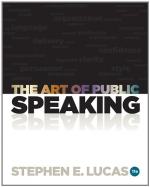The purpose of a gesture is to carry your thought and feeling into the minds and hearts of your hearers; this it does by emphasizing your message, by interpreting it, by expressing it in action, by striking its tone in either a physically descriptive, a suggestive, or a typical gesture—and let it be remembered all the time that gesture includes all physical movement, from facial expression and the tossing of the head to the expressive movements of hand and foot. A shifting of the pose may be a most effective gesture.
What is true of gesture is true of all life. If the people on the street turn around and watch your walk, your walk is more important than you are—change it. If the attention of your audience is called to your gestures, they are not convincing, because they appear to be—what they have a doubtful right to be in reality—studied. Have you ever seen a speaker use such grotesque gesticulations that you were fascinated by their frenzy of oddity, but could not follow his thought? Do not smother ideas with gymnastics. Savonarola would rush down from the high pulpit among the congregation in the duomo at Florence and carry the fire of conviction to his hearers; Billy Sunday slides to base on the platform carpet in dramatizing one of his baseball illustrations. Yet in both instances the message has somehow stood out bigger than the gesture—it is chiefly in calm afterthought that men have remembered the form of dramatic expression. When Sir Henry Irving made his famous exit as “Shylock” the last thing the audience saw was his pallid, avaricious hand extended skinny and claw-like against the background. At the time, every one was overwhelmed by the tremendous typical quality of this gesture; now, we have time to think of its art, and discuss its realistic power.
Only when gesture is subordinated to the absorbing importance of the idea—a spontaneous, living expression of living truth—is it justifiable at all; and when it is remembered for itself—as a piece of unusual physical energy or as a poem of grace—it is a dead failure as dramatic expression. There is a place for a unique style of walking—it is the circus or the cake-walk; there is a place for surprisingly rhythmical evolutions of arms and legs—it is on the dance floor or the stage. Don’t let your agility and grace put your thoughts out of business.
One of the present writers took his first lessons in gesture from a certain college president who knew far more about what had happened at the Diet of Worms than he did about how to express himself in action. His instructions were to start the movement on a certain word, continue it on a precise curve, and unfold the fingers at the conclusion, ending with the forefinger—just so. Plenty, and more than plenty, has been published on this subject, giving just such silly directions. Gesture is a thing of mentality and feeling—not a matter of geometry. Remember, whenever a pair of shoes, a method of pronunciation, or a gesture calls attention to itself, it is bad. When you have made really good gestures in a good speech your hearers will not go away saying, “What beautiful gestures he made!” but they will say, “I’ll vote for that measure.” “He is right—I believe in that.”




